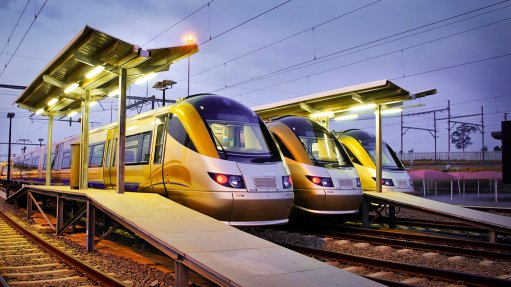
OFF-RAIL DIVERSIFICATION Gautrain has determined that more commercialisation efforts at its stations are needed, including mixed-use elements
For a high-speed commuter rail operator, such as Gautrain Management Agency, to remain commercially sustainable in the long term, it must consider multiple, new revenue streams.
Speaking during the Devac Infrastructure conference on May 17, Gautrain business planning executive manager Jared Grey said passenger rail systems in South Africa faced the challenge of operating in a commercially sustainable manner, especially in the wake of the Covid-19 pandemic.
Ridership took a major dip in 2021 and has yet to recover to pre-Covid-19 levels.
The lower ridership is being exacerbated by a weakened fiscus, with additional pressure on already constrained national budgets – which means Gautrain is “in no way able to be subsidised” – in addition to a changing work environment, including more work-from-home and flexi-hour schedules.
The commercial sustainability of a passenger rail service relies on sufficient ridership volume, economically competitive fares, government support, an enabling network of partners and investors, prudent cost management and commercialisation – the latter relating to activating alternative revenue sources, according to Grey.
The realisation of these factors contributes to not only positive customer sentiment and increased economic growth but also positive social impact.
In conducting research on passenger rail operators in developed and developing markets, Gautrain has found that the average operator generates 25% of its revenue from nonfare activity, including advertising, property development and retail.
With Gautrain still being in its infancy as a high-speed rail operator – having started operating in 2011, relative to an operator such as Mass Transit Railway (MTR), in China, which started operating in 1975 – it predominantly relies on fare revenue. MTR derives more than 70% of its revenue from nonfare activity.
Gautrain has an 80-km express railway line linking Johannesburg, Pretoria, Kempton Park and OR Tambo International Airport, but it is working on expanding the line to parts of Limpopo and Durban, which should help generate more fare revenue.
In the meantime, it has determined that more commercialisation efforts at its stations are needed, including incorporating mixed-use elements to capture a larger share of commuter time and enrich the passenger experience while catalysing wider economic benefits.
The operator plans on leveraging existing landholdings to drive property development and promote retail and lifestyle products across the Gautrain station network.
Gautrain also offers agency management as a service to stakeholders in the transport sector.
For example, Gautrain has helped to develop a Transport Management Centre for government, which is responsible for managing and coordinating information, data and traffic flows. The first phase of this development was launched in December last year.
It has also assisted government in establishing three smart driving licence testing centres in Midrand, Centurion and Sandton, to allow for quicker driver’s licence renewals, better processing of infringements and better booking of appointments.
Additionally, Gautrain has played an instrumental role in the deployment of the Gauteng provincial government’s Integrated Fare Management project, to support the integration of public transport.
To improve its revenue diversification, Gautrain will consider mixed-use development of the 350 untapped land parcels it owns. The operator intends to crowd in as much private-sector funding as possible.
Some initial plans include a mixed-use development at the Centurion station, which will comprise a retail boulevard and residential and office development totalling 47 000 m2 of gross leasable space.
Gautrain also plans to develop on-grade parking at Hatfield station, in Pretoria, as well as retail elements, which will comprise the Gautrain Square.
Other ideas include adding coffee shops to the stations in Midrand and Centurion, and courier service DSV’s smart lockers at some stations to provide riders with access to courier services.
Grey noted that Gautrain also wanted to tap into micro freight opportunities.
For the passenger rail operator to achieve long-term commercial sustainability, he emphasised that Gautrain would need legal amendments to its current scheduling and powers, the establishment of diversified business units with specific focus areas, access to capital markets and adequate funding, more public–private partnerships and support from the national fiscus.
Ultimately, Gautrain is aiming to partner with experts and innovators across industries to help realise its vision of becoming a diversified passenger rail operator.